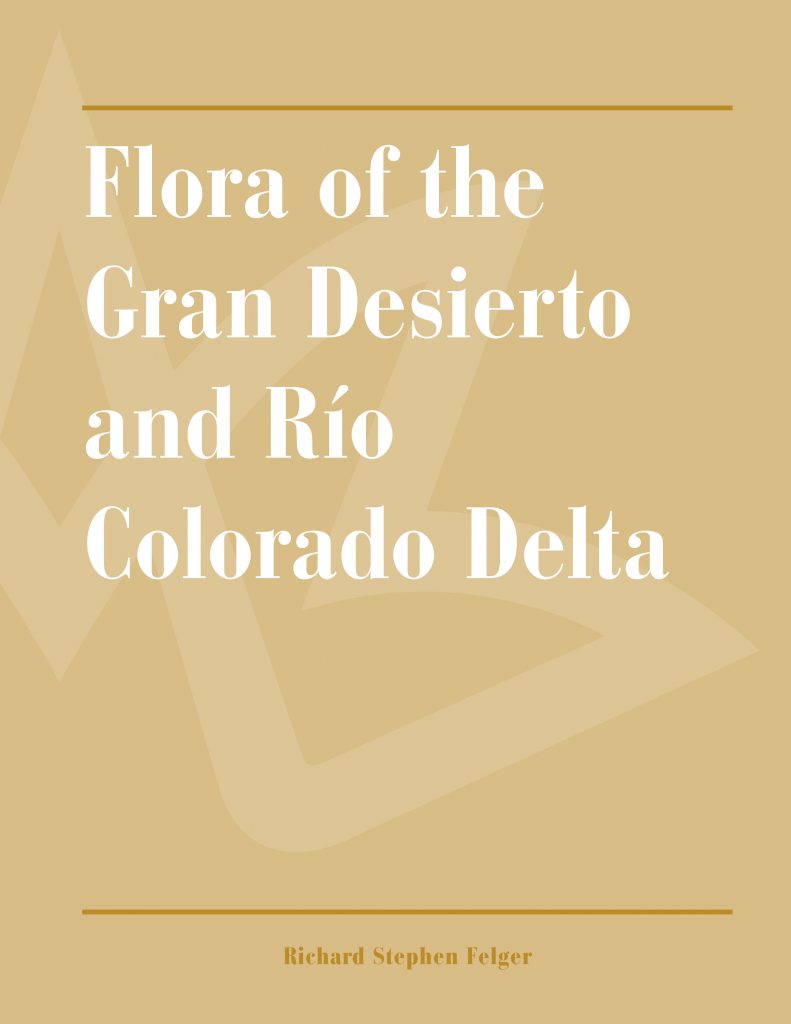Flora of the Gran Desierto and Río Colorado Delta
Paperback ($75.00), Ebook ($75.00)
Buy
From the Pinacate lava fields and expansive dunes to the shores of the Gulf of California, the Gran Desierto is one of the hottest and driest places in the Western Hemisphere. Yet this region in the state of Sonora in northwestern Mexico embraces a remarkable number of habitats with a fascinating and surprisingly rich flora. This is the heart of the Sonoran Desert, still in a largely primordial state, in juxtaposition with the ravished wetlands of the once great Río Colorado. Flora of the Gran Desierto is the culmination of more than twenty-five years of research in this magnificent desert and delta by botanist Richard Felger. This comprehensive floristic study of more than 565 species of vascular plants features original diagnostic descriptions and innovative identification keys to the families, genera, and species. Particular attention has been devoted to taxa that are poorly known. Even weeds and their histories are treated in detail. Hundreds of illustrations by such eminent botanical artists as Lucretia Brezeale Hamilton, Matt Johnson, and Bobbi Angell will aid in the identification of plants.
Common names of plants are given in English, Spanish, and O'odham. While emphasizing scientific accuracy, the book is written in an accessible style. Felger's observations and knowledge of plant ecology, geographic distribution, evolution, ethnobotany, plant variation and special adaptations, and the history of the region provides botanists, naturalists, ecologists, conservationists, and anyone else celebrating the desert with readable, interesting, and important information. With two of Mexico's newest biosphere reserves—the Pinacate and the Upper Gulf of California—this region is a keystone for desert conservation efforts. Its location linking vast preserves to the north makes this book especially useful for anyone interested in borderland studies and the Sonoran Desert. Flora of the Gran Desierto represents a most creative, definitive, and enthusiastic treatment of Sonoran Desert plant life and is highly relevant to ecological restoration in deserts and wetlands in arid places worldwide.
Common names of plants are given in English, Spanish, and O'odham. While emphasizing scientific accuracy, the book is written in an accessible style. Felger's observations and knowledge of plant ecology, geographic distribution, evolution, ethnobotany, plant variation and special adaptations, and the history of the region provides botanists, naturalists, ecologists, conservationists, and anyone else celebrating the desert with readable, interesting, and important information. With two of Mexico's newest biosphere reserves—the Pinacate and the Upper Gulf of California—this region is a keystone for desert conservation efforts. Its location linking vast preserves to the north makes this book especially useful for anyone interested in borderland studies and the Sonoran Desert. Flora of the Gran Desierto represents a most creative, definitive, and enthusiastic treatment of Sonoran Desert plant life and is highly relevant to ecological restoration in deserts and wetlands in arid places worldwide.
"While emphasizing scientific accuracy, the book is beautifully designed with more than 400 illustrations, and written in a clear and accessible style. Felger's observations and knowledge of plant ecology, geographic distribution, evolution, ethnobotany, plant variation and special adaptations, and history of the region will provide botanists, natural historians, ecologists, conservationists and anyone celebrating the desert, with readable, interesting, and important information." —Desert Plants
"For biologists and conservationists with an interest in American desert floras or simply in the flora of western North America, this book is a must-have." —SIDA
"For those who want to use the book as a botanical reference, it is unbeatable and will, I think, remain the classic for many years to come. . . . Through this excellent book, we can learn more about the ways plants adapt to a harsh environment." —Journal of Arizona History
"The reader should not be misled by the seemingly narrow geographical boundaries. The book not only provides carefully researched plant descriptions, but offers insights and a rich discussion of processes that occur in arid lands around the world. In addition to the taxonomic information, a rich trove of ecological and historical data is packed into each of the plant descriptions." —Plant Systematics and Evolution
"For biologists and conservationists with an interest in American desert floras or simply in the flora of western North America, this book is a must-have." —SIDA
"For those who want to use the book as a botanical reference, it is unbeatable and will, I think, remain the classic for many years to come. . . . Through this excellent book, we can learn more about the ways plants adapt to a harsh environment." —Journal of Arizona History
"The reader should not be misled by the seemingly narrow geographical boundaries. The book not only provides carefully researched plant descriptions, but offers insights and a rich discussion of processes that occur in arid lands around the world. In addition to the taxonomic information, a rich trove of ecological and historical data is packed into each of the plant descriptions." —Plant Systematics and Evolution
 The University of Arizona Press
The University of Arizona Press

